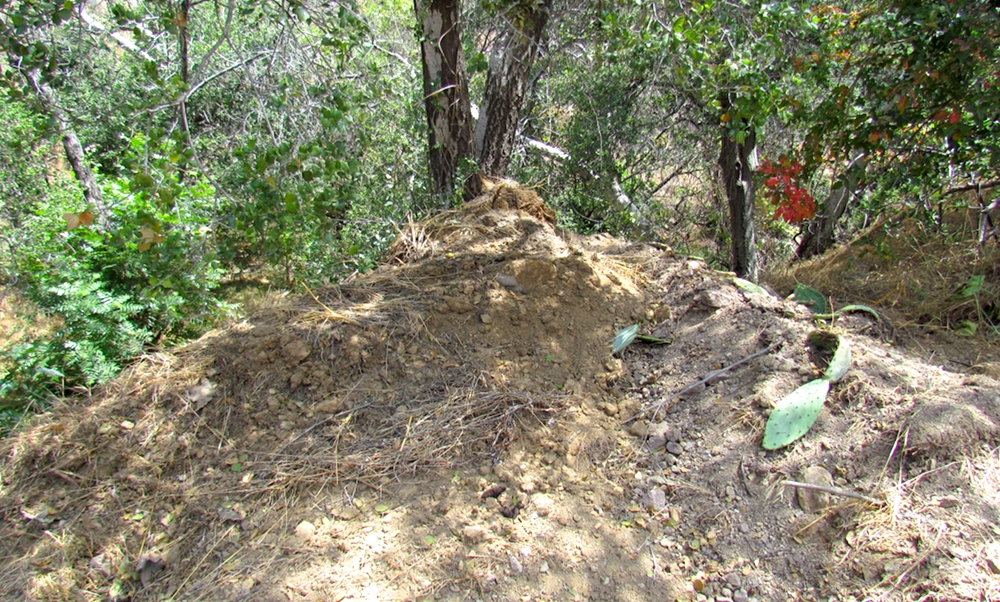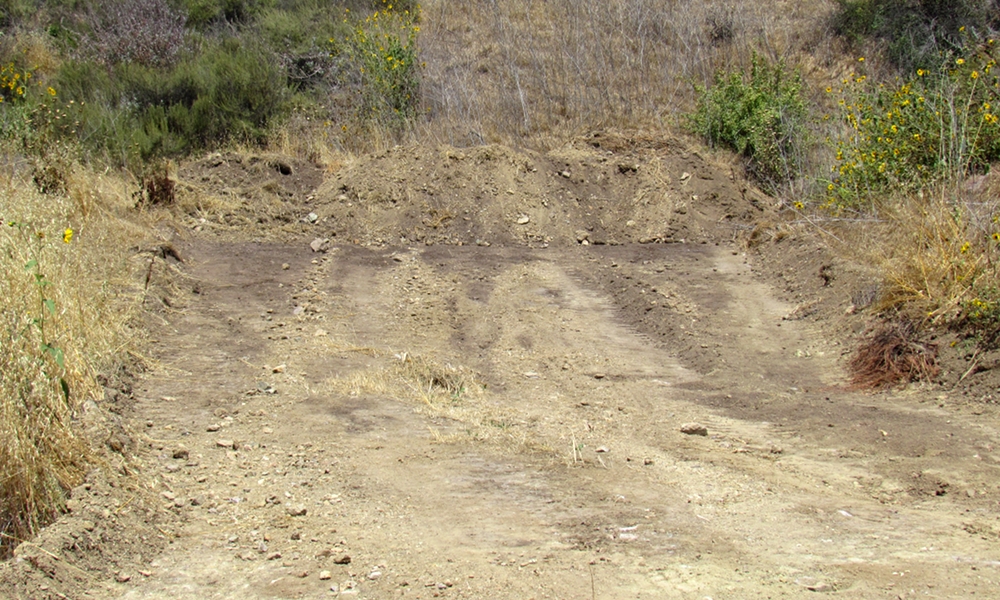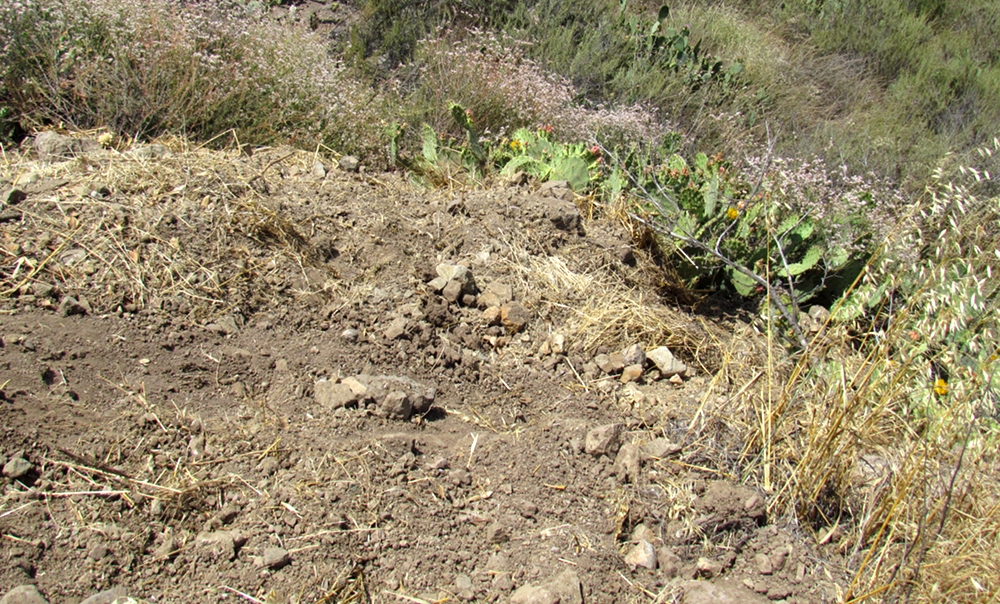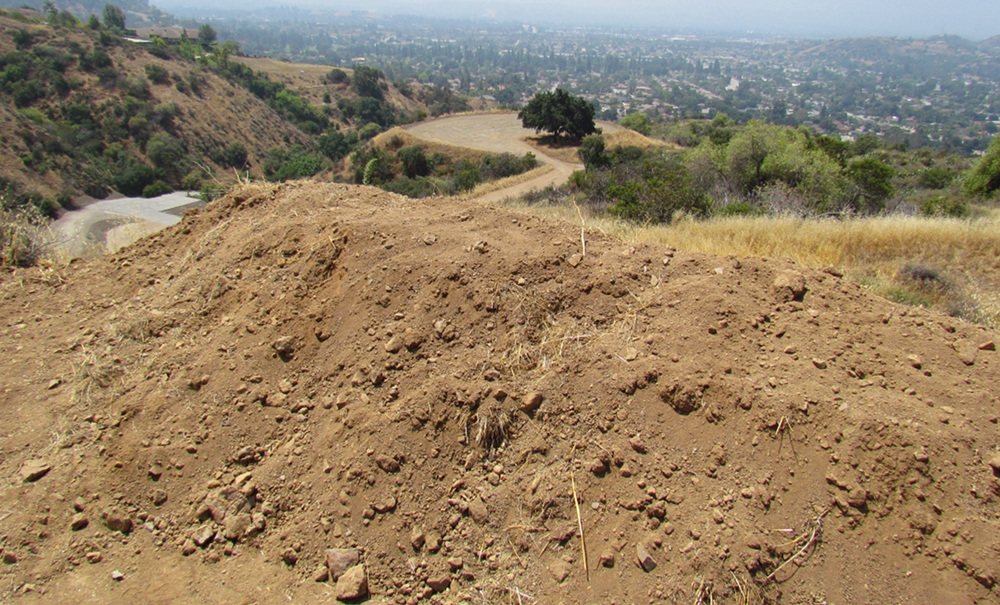Routine fire clearance work performed by the Los Angeles County Fire Department last month may have been anything but routine after a local conservancy claims protected habitat on Bluebird Ranch was heavily damaged.
The Glendora Community Conservancy, which owns and maintains 340 acres of Glendora’s foothills, alleges fire crews caused “major devastation” by allegedly widening the narrow fire access road, crushing some of the cactus habitat home to an endangered bird and killing oak trees by piling dirt against them.
Members of the Sierra Club discovered the alleged damage May 20, according to Ann Croissant, director of the Glendora Community Conservancy. As many as 20 different sites were documented with various levels of damage to the habitat.

Large dirt mounds were pushed up against some oak trees along the fire access road, potentially killing them. Photo by Aaron Castrejon.
“They graded deep and they pushed all that dirt off the road right into the habitat. It’s supposed to stay within the road boundary,” Croissant said. “It’s the first time all that new dirt had been dumped over into the habitat.
“When you see dirt … maybe three to four feet high on the side of an oak three, you killed because you not only ripped up the drip lines and the roots, you’ve also put the dirt right up on the bark. You’re going to get a lot of fungal activity,” Croissant said.
Jurisdictional issues have persisted for years near conservancy land, Croissant said. “It’s one of the worst things we’ve had to deal with along the foothill corridor.”
The initial work was conducted the week of May 16. Two passes with heavy machinery are conducted annually.
“It was our annual clearance of the fire roads. We do them every year,” said Fire Fighter Specialist Richard Licon of the Los Angeles County Fire Department. “It’s the roads we have to clear in that area to get our equipment to.”

Fire personnel allegedly pushed mounds of dirt many feet off the main road, according to the Conservancy. Photo by Aaron Castrejon.
The Conservancy contacted the California Department of Fish & Wildlife who, in turn, notified the city to investigate the claims.
“CDFW has opened an investigation on maintenance procedures and the possible damage done to the habitat by recent road and stream bed grading work. We will investigate fully and release the findings when the investigation is complete,” said Andrew Hughan, public information officer for the California Department of Fish & Wildlife.
The U.S. Army Corps of Engineers and the California Wildlife Conservation Board are also investigating.
GCN was provided a tour of the alleged damage caused by the fire clearance work.
The work appears to have widened Ferguson Motorway and portions of Gordon Ranch Road beyond their original borders, basically transforming them into a two-lane road. Large mounds of dirt were pushed about three feet high against some oak trees and dirt pushed over into south-facing cactus habitats.
Heavy machinery also allegedly crushed some south-facing cactus habitats, which are home to the endangered Coastal Cactus Wren.

Mounds of dirt were pushed over the roadside, allegedly damaged south-facing cactus habitat which is home to the endangered Coastal Cactus Wren. Photo by Aaron Castrejon.
“We’re talking about decades that this land takes to recover. We don’t have the caring capacity anymore to have clean air, water and soil if we destroy the very habitats around us that are natural cleaners of air, water and soil,” Croissant said.
In a series of emails provided to GCN, Acting Assistant Fire Chief Jim Enriquez told Glendora City Manager Chris Jeffers that the scheduled maintenance enables ground access into “undeveloped areas” to protect homes.
“Fire roads allows ground resources to establish an anchor point on a fire flank with engine companies, dozers and/or hand crews personnel away from homes at risk of an approaching brush fire,” Enriquez said in the email.
Enriquez has yet to return a GCN request for a phone interview.
Jeffers, City Attorney D. Wayne Leech and Planning Director Jeff Kugel toured Bluebird Ranch to observe the reported damage. Jeffers reports the work done was on the road only and not outside the road’s boundaries.
“We walked it and took pictures and out of the pictures, we saw the work was done on the fire service road and within the boundaries of the road itself. On Gordon Mull, the Fire Department cleared two of the pads, which they annually do,” Jeffers said.
He added that he has seen photos provided by Ann Croissant that show the cactus damage, but clearance needs to be made to keep vegetation from impeding access to the fire service roads.
“They’re just cutting back vegetation that has grown into their road,” Jeffers said.
The fire crews also allegedly performed illegal grading on the pads for the proposed 18-home Gordon Mull project.

A large mound of dirt almost four feet high was pushed off near Gordon Ranch Road, while a dirt lot seen in the distance was one of a few possibly illegally graded. Photo by Aaron Castrejon.
“In our opinion, [fire crews] took liberties past just maintaining the road by pushing soil past the dirt road,” said Mark Lamoureux, a civil engineer assisting the Gordon Mull developer.
In an email conversation with Jeffers, Lamoureux said he and others walked the fire road Saturday, May 21 and found four lots having been scraped by heavy equipment.
“We did not give verbal or written permission for anyone to go onto the Gordon Ranch Estates in conjunction with this recent work. If the work was done by a public agency as part of a public safety maintenance measure for the dirt fire road, then they should be reprimanded for working past the limits of the road by the city,” Lamoureux wrote.
Enriquez argued that the pads were graded to provide a safety measure for fire fighters.
“Our operators will clear brush off pre-exsiting flat dirt areas, creating a Temporary Refuge Area … an area/site free of combustible vegetation so that firefighters can quickly secure short-term relief from unexpected flare-ups or adverse changes in fire behavior,” Enriquez said.
The city of Glendora has a conservation easement with the Conservancy due to the land’s “significant wildlife habitat, aesthetic and ecological values,” according to the Conservation Easement document obtained by GCN.
The Easement also states that the land be protected “predominantly in its natural, scenic and open space condition and to prevent any use of the Property that will impair or interfere with the Conservation Values of the property.”
The construction of fire roads for fire protection, public health and safety, however, is allowed under the Easement.
City officials have turned over a report of the alleged damage to the state, saying fire crews conducted work within their purview of fire protection, within the boundaries of the road and did not violate the conditions of the Easement, Jeffers said.
Possibly as soon as next week, fire crews will return for a second phase of fire road grading in the area.





